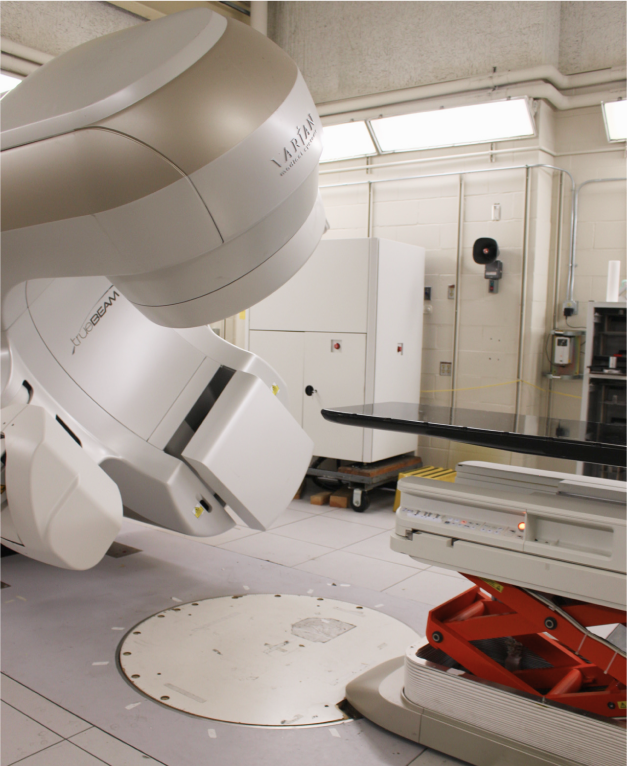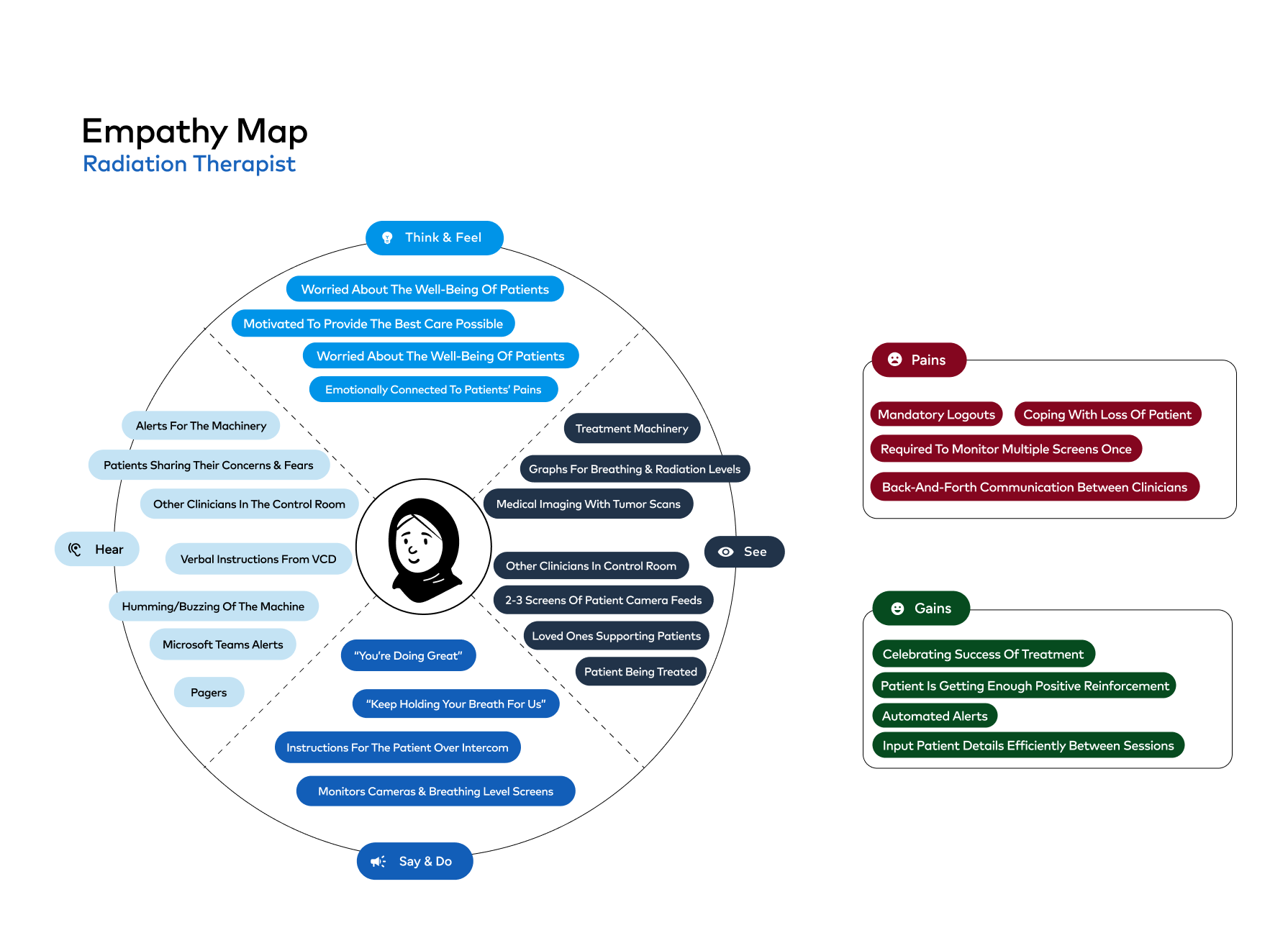Breath Work for
Radiation Therapy
Varian is a company that makes hardware and software for radiation therapy. This was a collaboration for my capstone project for a Master of Human-Computer Interaction and Design at University of California, Irvine. Varian worked with our team as contractors to find a solution for motion management that occurs during radiation therapy.
problem
The exact problem statement that the Varian Design Team presented us with was:
“Develop a concept for a motion management solution that can be tailored based on different clinical needs and budgets.”
literature review
To get started in this project we had to educate ourselves of the radiation therapy space. In the literature review, we compiled information about:
Cancer as a disease
Radiation therapy as a practice
The forms of radiation therapy in use today
The importance of precision and dose in radiation therapy
Motion Management solutions
Varian's Motion Management technology and its applications
The limitations of Varian's existing motion management solution
Competitors in the field
competitive analysis insights
-
1
The majority of motion management products either do not interface with others or do so only with a select few competitors .
-
2
Competitors often employ a combination of motion management techniques in order to reduce patient discomfort and improve radiation accuracy.
-
3
Motion management solutions are highly customizable but still require constant manual use, reducing time spent with the patient.
Varian Labs In Person
-

Varian Labs
To learn more about Varian products and what they do, our team did an on site visit to their labs and facilities in Palo Alto, California. Here we toured the manufacturing facility and learned about the True Beam machine in the simulation QA enviornment.
-

Motion Management Matching
This is one of seven monitors the Radiation Therapist are looking at when conducting radiation therapy. This monitor is showing the patients positioning and helping align them in the same position they were in during their simulation planning.
-

Visual Coaching Device
This monitor is the visual coaching device (VCD) that the patient views during treatment. This VCD is a visual guide for the patient to align their breathing with to ensure they are within the range set for the radiation beam.
Clinician Interviews
To begin our stakeholder interview journey, we leveraged the findings from our literature review to identify the key stakeholders involved in the radiation therapy process. We knew that we would need to interview radiation oncologists, radiation therapists, physicists and dosimetrists to get a sense of the full radiation therapy picture. With these roles identified, we worked with a radiation therapist at Mayo Clinic to recruit participants from each of these professional backgrounds for our research. In total, we recruited and interviewed; four radiation therapists, one radiation oncologist, two physicists, one dosimetrist, one veterinary radiation oncologist.
Empathy Map : Radiation Therapist
After our interviews we created empathy maps for the main stakeholders invloved in our problem space. First, we outlined the radiation therapist and their thoughts, feelings, sights, what they hear and see.
Empathy Map: Patient
The next stakeholder we outlined was the patient. We captured our future users' emotions, thoughts, and behaviors to gain an empathetic understanding of their needs, challenges, and experiences - the ultimate goal being to develop a solution that truly resonated with our target audience.
Iterative Testing Round One
Persona Subject
Craig is a lung cancer patient undergoing radiation treatment.
Use Case One
At home, he clicks an app icon on his smartphone and immediately lands on a screen prompting him to choose a breathing technique (inhale hold, exhale hold, or free breathing). Craig chooses exhale hold, and is led to a screen in which he can practice regulating his breathing and holding his breath for the duration of a typical treatment session.
Use Case Two
At home, he clicks an app icon on his smartphone and is prompted to log in or sign up for an account. Upon login, Craig is sent to a dashboard where he can choose to message his care team, practice the breathing techniques necessary during treatment, or set preferences that will pass over to the care team’s system. He chooses to work on his breathing exercises, and is led to a screen that displays the exercise for the technique that was assigned by his treatment team.
Testing Insights
In general, patients struggled to feel heard by their doctors and care team. This validated the need for a history section where patients could keep logs of the breathing techniques that were practiced to reference during a treatment appointment.
Patients mental health suffers during treatment and they look for ways to relieve the accompanying anxiety.
The existing patient portals used by patients do not have any integrated breathing exercises or motion management education training.
Iterative Testing Round Two
Testing Insights
We gathered the need for a comprehensive onboarding experience that accommodates for mental fog that patients experience at this time. Along with onboarding we defined a clear brand voice and use of terminology to provide concise and clear explanations.
Patients voiced about wanting to learn as much as possible about radiation therapy. So we added in a resource library with common FAQs so patients can be educated and feel informed about this process.
Some patients were not as familiar with these breathing techniques and were primarily part of the older adult population. Because of this we added a help and tutorial section that can be accessed at any time to guide them through the app.
Iterative Testing Round Three
Testing Insights
Patients saw the benefit to tracking your basic progress and wanted to see more data points about it, specifically on the homepage.
Patients wanted to see more instructions and descriptions for the breathing exercises. They expressed wanted to learn as much as possible to be best prepared for treatment.
Patients were also overwhelmed as some points with the duration of steps or actions needed while navigating the app.
Iterative Testing Round Four
Testing Insights
Patients provided positive feedback about the usages of the app. This validated the need for it in this space during radiation treatment planning and simulation.
There was validation regarding the calming color palette used and the breathing exercises themselves were straightforward to follow along to.
Overall there were minor items patients pointed out such as extra verbiage clarification regarding setting breathing customizations.
Defining our Brand
In the dynamic world of healthcare technology, where functionality often overshadows human needs, our team took a different approach for our app. Instead of creating a generic solution, we wanted a brand that resonated with real emotions, real challenges, and real journeys. Our secret ingredient? Hearing first-hand from patients.The outcome was more than just a healthcare app; it's a companion in the cancer treatment journeys users - of patients. Our brand is synonymous with understanding, support, and empowerment. It isn't just about breathing exercises; it'd about feeling seen, heard, and cared for.












